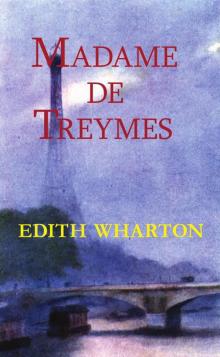- Home
- Edith Wharton
The New York Stories of Edith Wharton Page 3
The New York Stories of Edith Wharton Read online
Page 3
The story is poignant, not punishing; Wharton does not hold this society in contempt. She mocks its rituals but not their celebrants. The story records the end both of an era and of a particular kind of man—the social dandy. A measured and beautiful rendering of the final descent, it reminds us of our own connections to ceremony and society, our own vanities and shortcomings, our own inevitable plunge into darkness.
Wharton wrote brilliantly right up to the end of her life, and “Roman Fever,” of 1934, just three years before her death, is one of her great stories. It is not a quiet rumination on mortality but the summoning up of rage, stifled passion, and sexuality: a remarkable work for a woman of seventy-two.
Though the story is set entirely on a rooftop terrace in contemporary Rome, Old New York is a looming presence and provides the background of “two American ladies of ripe but well-cared-for middle age.” Friends since childhood, brownstone neighbors on East 73rd Street, now both widowed and the mothers of two marriageable daughters, the two sit decorously watching the sunset, “contemplating it in silence, with a sort of diffused serenity which might have been borrowed from the spring effulgence of the Roman skies.” Mrs. Slade thinks slightingly that her friend’s late husband “was—well, just the duplicate of his wife. Museum specimens of old New York. Good-looking, irreproachable, exemplary.”
Slowly, through conversation and reminiscence, the two matrons recall their younger selves, inducting us into its secret sisterhood as they remember a common visit to Rome some twenty-five years earlier. If New York represents a moribund rigidity, Rome embodies a dark, charged vitality, worldly and unfathomable. The fever of the title refers to malaria, a fatal nineteenth-century disease and a real threat before the Roman marshes were drained. Fever was the ostensible reason for keeping young women inside during the evenings. The risk of illness was real, but so was the other, unspoken reason for sequestration—sexual adventure, with its terrifying consequences.
Seated overlooking a ravishing twilit view of Rome, with its “great accumulated wreckage of passion and splendor,” the women are carried by the march of memory to the rising rhythm of animosity, through a landscape of jealousy and deception, illicit assignations, sexual thrall, and unwed pregnancy. It is a virtuoso’s performance, and Wharton’s greatest story of Old New York may be this one, set in Rome. Here she reverts to her most enduring theme, the power of passion—uncontrollable, inextinguishable, inexcusable. It is passion that has driven the lives of these two decorous matrons, and it is passion that reveals itself anew as they sit in the splendor of the Roman sunset.
Edith Wharton’s lifetime spanned the Victorian era, the First World War, the Jazz Age, and the Depression. It was a period of enormous transitions, subject to the competing forces of conservatism and modernism. In her work, the great changes she witnessed are set against the abiding presence of Old New York, which was, for all its limitations, Wharton’s touchstone, her social and moral measure, and the true north of her compass.
Her writing is hard to place, as her social and intellectual influences are so diverse. As a young woman, she schooled herself by reading nonfiction: history, philosophy, and scientific theory. This gave her a firm intellectual grounding and a rational, analytical approach to the world: she admired the novel of ideas, and the works of George Eliot and George Sand. One of her most powerful influences, however, was Nathaniel Hawthorne, whose dark Puritanism and punitive moral ethic was an important model for her. In his world, as in hers, passion is most often illicit, and renunciation and punishment are its consequences. Wharton’s stern judgmental moralism is often blurred by her appreciation of and delight in the sensual world, but it is Hawthorne’s bleak vision that offers the most direct antecedent to her own. Frequently, however, Wharton’s work is linked with that of Henry James, her friend and mentor, because of the social circles about which they both write, as well as the elegance, intelligence, and nuanced quality of their styles. James is a very different sort of writer, however, and his vision is interior and more mysterious than hers. Wharton’s work has more clarity and directness, more boldness and drama. It is also more modern. Wharton shares certain feminist concerns with her contemporary, Kate Chopin. Though no evidence shows that Wharton knew Chopin’s work, the two authors explore many of the same themes, offering similarly disconcerting revelations about the inner lives of women.
Wharton wrote about the twentieth century, but her formal, ceremonial style and her belief in a moral order linked her inextricably to the nineteenth. The next generation—Hemingway, Faulkner, and Fitzgerald, among others—shared a sense of post-war disillusionment, and experimented with literary styles whose fractured rhythms echoed those of the twentieth century. Despite her decorous style, however, Wharton is anything but prim. Her work is informed by candor, clarity, and a deep understanding of the great subversive force of the emotions. Perhaps only one to whom the life of the emotions has been so explicitly forbidden can truly understand its potency.
Socially, Wharton was an Edwardian—worldly, informed, confident. A member of a privileged and elitist society, she challenged its flaws and inequities, but also recognized its dignity and strengths. She was eloquent, proud, and perceptive, and as she witnessed the disruptions of modern life, she came to yearn for the order and ceremony she had once known. She was deeply committed to the concept of a moral order, though she recognized the complexities implied by its rule. She used the world into which she was born—the inner circles of Old New York—to create her own unique and individual landscape, as all great writers do. Wharton’s characters are flawed and struggling, weak and noble, loving and heartless. Her New York is diverse, precise, and entirely her own. It is a place of beauty, complication, and authenticity.
Wharton’s work was overlooked for many years because of its awkward placement, stranded between the nineteenth and twentieth centuries. Returned now to its rightful prominence in the history of American letters, it offers a profound and moving reflection on desire and its consequences, on freedom and its limits in American life.
The twenty stories collected here show Edith Wharton’s world as she knew it. They show the crystalline brilliance of her literary style; they show the intellectual reach and complexity of her mind. They show the courage, depth, and compassion of her heart. They show her to be one of our greatest short-story writers.
—ROXANA ROBINSON
THE NEW YORK STORIES OF EDITH WHARTON
MRS. MANSTEY’S VIEW
THE VIEW from Mrs. Manstey’s window was not a striking one, but to her at least it was full of interest and beauty. Mrs. Manstey occupied the back room on the third floor of a New York boarding-house, in a street where the ash-barrels lingered late on the sidewalk and the gaps in the pavement would have staggered a Quintus Curtius. She was the widow of a clerk in a large wholesale house, and his death had left her alone, for her only daughter had married in California, and could not afford the long journey to New York to see her mother. Mrs. Manstey, perhaps, might have joined her daughter in the West, but they had now been so many years apart that they had ceased to feel any need of each other’s society, and their intercourse had long been limited to the exchange of a few perfunctory letters, written with indifference by the daughter, and with difficulty by Mrs. Manstey, whose right hand was growing stiff with gout. Even had she felt a stronger desire for her daughter’s companionship, Mrs. Manstey’s increasing infirmity, which caused her to dread the three flights of stairs between her room and the street, would have given her pause on the eve of undertaking so long a journey; and without perhaps formulating these reasons she had long since accepted as a matter of course her solitary life in New York.
She was, indeed, not quite lonely, for a few friends still toiled up now and then to her room; but their visits grew rare as the years went by. Mrs. Manstey had never been a sociable woman, and during her husband’s lifetime his companionship had been all-sufficient to her. For many years she had cherished a desire to live in the country, to have a
hen-house and a garden; but this longing had faded with age, leaving only in the breast of the uncommunicative old woman a vague tenderness for plants and animals. It was, perhaps, this tenderness which made her cling so fervently to her view from her window, a view in which the most optimistic eye would at first have failed to discover anything admirable.
Mrs. Manstey, from her coign of vantage (a slightly projecting bow-window where she nursed an ivy and a succession of unwholesome-looking bulbs), looked out first upon the yard of her own dwelling, of which, however, she could get but a restricted glimpse. Still, her gaze took in the topmost boughs of the ailanthus below her window, and she knew how early each year the clump of dicentra strung its bending stalk with hearts of pink.
But of greater interest were the yards beyond. Being for the most part attached to boarding-houses they were in a state of chronic untidiness and fluttering, on certain days of the week, with miscellaneous garments and frayed table-cloths. In spite of this Mrs. Manstey found much to admire in the long vista which she commanded. Some of the yards were, indeed, but stony wastes, with grass in the cracks of the pavement and no shade in spring save that afforded by the intermittent leafage of the clothes-lines. These yards Mrs. Manstey disapproved of, but the others, the green ones, she loved. She had grown used to their disorder; the broken barrels, the empty bottles and paths unswept no longer annoyed her; hers was the happy faculty of dwelling on the pleasanter side of the prospect before her.
In the very next enclosure did not a magnolia open its hard white flowers against the watery blue of April? And was there not, a little way down the line, a fence foamed over every May by lilac waves of wistaria? Farther still, a horse-chestnut lifted its candelabra of buff and pink blossoms above broad fans of foliage; while in the opposite yard June was sweet with the breath of a neglected syringa, which persisted in growing in spite of the countless obstacles opposed to its welfare.
But if nature occupied the front rank in Mrs. Manstey’s view, there was much of a more personal character to interest her in the aspect of the houses and their inmates. She deeply disapproved of the mustard-colored curtains which had lately been hung in the doctor’s window opposite; but she glowed with pleasure when the house farther down had its old bricks washed with a coat of paint. The occupants of the houses did not often show themselves at the back windows, but the servants were always in sight. Noisy slatterns, Mrs. Manstey pronounced the greater number; she knew their ways and hated them. But to the quiet cook in the newly painted house, whose mistress bullied her, and who secretly fed the stray cats at nightfall, Mrs. Manstey’s warmest sympathies were given. On one occasion her feelings were racked by the neglect of a house-maid, who for two days forgot to feed the parrot committed to her care. On the third day, Mrs. Manstey, in spite of her gouty hand, had just penned a letter, beginning: “Madam, it is now three days since your parrot has been fed,” when the forgetful maid appeared at the window with a cup of seed in her hand.
But in Mrs. Manstey’s more meditative moods it was the narrowing perspective of far-off yards which pleased her best. She loved, at twilight, when the distant brown-stone spire seemed melting in the fluid yellow of the west, to lose herself in vague memories of a trip to Europe, made years ago, and now reduced in her mind’s eye to a pale phantasmagoria of indistinct steeples and dreamy skies. Perhaps at heart Mrs. Manstey was an artist; at all events she was sensible of many changes of color unnoticed by the average eye, and dear to her as the green of early spring was the black lattice of branches against a cold sulphur sky at the close of a snowy day. She enjoyed, also, the sunny thaws of March, when patches of earth showed through the snow, like ink-spots spreading on a sheet of white blotting-paper; and, better still, the haze of boughs, leafless but swollen, which replaced the clear-cut tracery of winter. She even watched with a certain interest the trail of smoke from a far-off factory chimney, and missed a detail in the landscape when the factory was closed and the smoke disappeared.
Mrs. Manstey, in the long hours which she spent at her window, was not idle. She read a little, and knitted numberless stockings; but the view surrounded and shaped her life as the sea does a lonely island. When her rare callers came it was difficult for her to detach herself from the contemplation of the opposite window-washing, or the scrutiny of certain green points in a neighboring flower-bed which might, or might not, turn into hyacinths, while she feigned an interest in her visitor’s anecdotes about some unknown grandchild. Mrs. Manstey’s real friends were the denizens of the yards, the hyacinths, the magnolia, the green parrot, the maid who fed the cats, the doctor who studied late behind his mustard-colored curtains; and the confidant of her tenderer musings was the church-spire floating in the sunset.
One April day, as she sat in her usual place, with knitting cast aside and eyes fixed on the blue sky mottled with round clouds, a knock at the door announced the entrance of her landlady. Mrs. Manstey did not care for her landlady, but she submitted to her visits with ladylike resignation. To-day, however, it seemed harder than usual to turn from the blue sky and the blossoming magnolia to Mrs. Sampson’s unsuggestive face, and Mrs. Manstey was conscious of a distinct effort as she did so.
“The magnolia is out earlier than usual this year, Mrs. Sampson,” she remarked, yielding to a rare impulse, for she seldom alluded to the absorbing interest of her life. In the first place it was a topic not likely to appeal to her visitors and, besides, she lacked the power of expression and could not have given utterance to her feelings had she wished to.
“The what, Mrs. Manstey?” inquired the landlady, glancing about the room as if to find there the explanation of Mrs. Manstey’s statement.
“The magnolia in the next yard—in Mrs. Black’s yard,” Mrs. Manstey repeated.
“Is it, indeed? I didn’t know there was a magnolia there,” said Mrs. Sampson, carelessly. Mrs. Manstey looked at her; she did not know that there was a magnolia in the next yard!
“By the way,” Mrs. Sampson continued, “speaking of Mrs. Black reminds me that the work on the extension is to begin next week.”
“The what?” it was Mrs. Manstey’s turn to ask.
“The extension,” said Mrs. Sampson, nodding her head in the direction of the ignored magnolia. “You knew, of course, that Mrs. Black was going to build an extension to her house? Yes, ma’am. I hear it is to run right back to the end of the yard. How she can afford to build an extension in these hard times I don’t see; but she always was crazy about building. She used to keep a boarding-house in Seventeenth Street, and she nearly ruined herself then by sticking out bow-windows and what not; I should have thought that would have cured her of building, but I guess it’s a disease, like drink. Anyhow, the work is to begin on Monday.”
Mrs. Manstey had grown pale. She always spoke slowly, so the landlady did not heed the long pause which followed. At last Mrs. Manstey said: “Do you know how high the extension will be?”
“That’s the most absurd part of it. The extension is to be built right up to the roof of the main building; now, did you ever?”
Mrs. Manstey paused again. “Won’t it be a great annoyance to you, Mrs. Sampson?” she asked.
“I should say it would. But there’s no help for it; if people have got a mind to build extensions there’s no law to prevent ’em, that I’m aware of.” Mrs. Manstey, knowing this, was silent. “There is no help for it,” Mrs. Sampson repeated, “but if I am a church member, I wouldn’t be so sorry if it ruined Eliza Black. Well, good-day, Mrs. Manstey; I’m glad to find you so comfortable.”
So comfortable—so comfortable! Left to herself the old woman turned once more to the window. How lovely the view was that day! The blue sky with its round clouds shed a brightness over everything; the ailanthus had put on a tinge of yellow-green, the hyacinths were budding, the magnolia flowers looked more than ever like rosettes carved in alabaster. Soon the wistaria would bloom, then the horse-chestnut; but not for her. Between her eyes and them a barrier of brick and mortar would swiftly
rise; presently even the spire would disappear, and all her radiant world be blotted out. Mrs. Manstey sent away untouched the dinner-tray brought to her that evening. She lingered in the window until the windy sunset died in bat-colored dusk; then, going to bed, she lay sleepless all night.
Early the next day she was up and at the window. It was raining, but even through the slanting gray gauze the scene had its charm—and then the rain was so good for the trees. She had noticed the day before that the ailanthus was growing dusty.
“Of course I might move,” said Mrs. Manstey aloud, and turning from the window she looked about her room. She might move, of course; so might she be flayed alive; but she was not likely to survive either operation. The room, though far less important to her happiness than the view, was as much a part of her existence. She had lived in it seventeen years. She knew every stain on the wall-paper, every rent in the carpet; the light fell in a certain way on her engravings, her books had grown shabby on their shelves, her bulbs and ivy were used to their window and knew which way to lean to the sun. “We are all too old to move,” she said.
That afternoon it cleared. Wet and radiant the blue reappeared through torn rags of cloud; the ailanthus sparkled; the earth in the flower-borders looked rich and warm. It was Thursday, and on Monday the building of the extension was to begin.
On Sunday afternoon a card was brought to Mrs. Black, as she was engaged in gathering up the fragments of the boarders’ dinner in the basement. The card, black-edged, bore Mrs. Manstey’s name.
“One of Mrs. Sampson’s boarders; wants to move, I suppose. Well, I can give her a room next year in the extension. Dinah,” said Mrs. Black, “tell the lady I’ll be upstairs in a minute.”
Mrs. Black found Mrs. Manstey standing in the long parlor garnished with statuettes and antimacassars; in that house she could not sit down.

 The Age of Innocence
The Age of Innocence The Reef
The Reef Summer
Summer The Glimpses of the Moon
The Glimpses of the Moon Xingu
Xingu The Fruit of the Tree
The Fruit of the Tree Fast and Loose
Fast and Loose Artemis to Actaeon and Other Verse
Artemis to Actaeon and Other Verse The Line of Least Resistance
The Line of Least Resistance The Lamp of Psyche
The Lamp of Psyche The Reckoning
The Reckoning Afterward
Afterward The New York Stories of Edith Wharton
The New York Stories of Edith Wharton The 2014 Halloween Horrors Megapack
The 2014 Halloween Horrors Megapack 'Copy': A Dialogue
'Copy': A Dialogue The Recovery
The Recovery The Fulness of Life
The Fulness of Life Early Short Stories Vol. 1
Early Short Stories Vol. 1 Tales of Men and Ghosts
Tales of Men and Ghosts The House of the Dead Hand
The House of the Dead Hand That Good May Come
That Good May Come The Buccaneers
The Buccaneers Other Times, Other Manners
Other Times, Other Manners The Hermit and the Wild Woman
The Hermit and the Wild Woman Kerfol
Kerfol The Duchess at Prayer
The Duchess at Prayer Bunner Sisters
Bunner Sisters The Choice
The Choice Madame De Treymes
Madame De Treymes Ethan Frome, Summer, Bunner Sisters
Ethan Frome, Summer, Bunner Sisters In Morocco
In Morocco The Valley of Decision
The Valley of Decision Age of Innocence (Barnes & Noble Classics Series)
Age of Innocence (Barnes & Noble Classics Series) The Angel at the Grave
The Angel at the Grave April Showers
April Showers Sanctuary
Sanctuary The Bunner Sisters
The Bunner Sisters Mrs. Manstey's View
Mrs. Manstey's View Writing a War Story
Writing a War Story The Custom of the Country
The Custom of the Country In Trust
In Trust The Triumph of the Night
The Triumph of the Night The Hermit and the Wild Woman, and Other Stories
The Hermit and the Wild Woman, and Other Stories Roman Fever and Other Stories
Roman Fever and Other Stories The Mission of Jane
The Mission of Jane The Descent of Man and Other Stories
The Descent of Man and Other Stories Coming Home
Coming Home The Touchstone
The Touchstone Early Short Stories Vol. 2
Early Short Stories Vol. 2 Edith Wharton's Verse, 1879-1919, from various journals.
Edith Wharton's Verse, 1879-1919, from various journals.